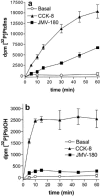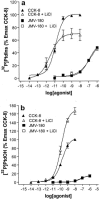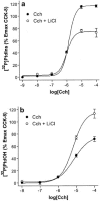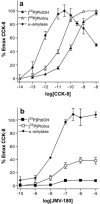The cholecystokinin analogues JMV-180 and CCK-8 stimulate phospholipase C through the same binding site of CCK(A) receptor in rat pancreatic acini
- PMID: 11498507
- PMCID: PMC1621142
- DOI: 10.1038/sj.bjp.0704190
The cholecystokinin analogues JMV-180 and CCK-8 stimulate phospholipase C through the same binding site of CCK(A) receptor in rat pancreatic acini
Abstract
1. This study was designed to address the controversy related to the involvement of phospholipase C in the signalling pathway linked to CCK(A) receptor stimulation by the cholecystokinin analogue JMV-180, a full agonist for amylase release, in rat pancreatic acini. 2. JMV-180 was shown to stimulate phospholipase C by measuring the incorporation of [(32)P]-orthophosphoric acid ([(32)P]-Pi) into phosphatidic acid (PtdOH) and phosphatidylinositol (PtdIns). Both responses elicited by JMV-180 were time and concentration dependent. Maximal effects elicited by JMV-180 were 39.08+/-0.72 and 8.02+/-0.40% for the labelling of [(32)P]-PtdIns and [(32)P]-PtdOH, respectively, as compared to the maximal effects of CCK-8, a full agonist of the CCK(A) receptor. 3. [(32)P]-Pi incorporation into PtdOH and PtdIns was sensitive to lithium, demonstrating that both responses are a consequence of phospholipase C activation. However, since lithium blocks the phosphoinositide cycle by an uncompetitive mechanism, its effect was only apparent at high concentrations of CCK-8 (>10 pM), which elicited stimuli above 20 and 60% of the maximal [(32)P]-PtdOH and [(32)P]-PtdIns labelling, respectively. 4. JMV-180 inhibited the incorporation of [(32)P]-Pi into PtdOH and PtdIns as stimulated by CCK-8, down to its own maximal effect. The estimated IC(50) values for the inhibition curves were not significantly different from those calculated assuming the same single binding site for both agonists. These results indicated that the well established role of JMV-180 as a partial agonist for CCK(A) receptor-linked signalling responses, also applies for the stimulation of phospholipase C. 5. The comparison of CCK-8 and JMV-180 dose-response curves of amylase release to those of PtdIns and PtdOH labelling with [(32)P]-Pi showed the existence of an amplification mechanism between phospholipase C and amylase release for both agonists. 6. In conclusion, we show that JMV-180, as well as CCK-8, stimulate phospholipase C upon interaction with the same binding site at the CCK(A) receptor in rat pancreatic acini.
Figures





Similar articles
-
Two functionally distinct cholecystokinin receptors show different modes of action on Ca2+ mobilization and phospholipid hydrolysis in isolated rat pancreatic acini. Studies using a new cholecystokinin analog, JMV-180.J Biol Chem. 1990 Apr 15;265(11):6247-54. J Biol Chem. 1990. PMID: 1690723
-
High-affinity CCK receptors are coupled to phospholipase A2 pathways to mediate pancreatic amylase secretion.Am J Physiol. 1995 Sep;269(3 Pt 1):G435-44. doi: 10.1152/ajpgi.1995.269.3.G435. Am J Physiol. 1995. PMID: 7573455
-
CCK-JMV-180: a peptide that distinguishes high-affinity cholecystokinin receptors from low-affinity cholecystokinin receptors.Biochim Biophys Acta. 1989 Feb 9;1010(2):145-50. doi: 10.1016/0167-4889(89)90154-7. Biochim Biophys Acta. 1989. PMID: 2463851
-
Novel CCK analogs for studying CCK-B receptor.Ann N Y Acad Sci. 1994 Mar 23;713:107-17. doi: 10.1111/j.1749-6632.1994.tb44056.x. Ann N Y Acad Sci. 1994. PMID: 8185151 Review. No abstract available.
-
Natural and synthetic CCK-58. Novel reagents for studying cholecystokinin physiology.Ann N Y Acad Sci. 1994 Mar 23;713:11-21. doi: 10.1111/j.1749-6632.1994.tb44047.x. Ann N Y Acad Sci. 1994. PMID: 7514372 Review.
Cited by
-
Comparative pharmacology of cholecystokinin induced activation of cultured vagal afferent neurons from rats and mice.PLoS One. 2012;7(4):e34755. doi: 10.1371/journal.pone.0034755. Epub 2012 Apr 13. PLoS One. 2012. PMID: 22514663 Free PMC article.
-
TMEM16B determines cholecystokinin sensitivity of intestinal vagal afferents of nodose neurons.JCI Insight. 2019 Mar 7;4(5):e122058. doi: 10.1172/jci.insight.122058. eCollection 2019 Mar 7. JCI Insight. 2019. PMID: 30843875 Free PMC article.
References
-
- ABDEL-LATIF A.A. Calcium-mobilizing receptors, polyphosphoinositides, and the generation of second messengers. Pharmacol. Rev. 1986;38:227–272. - PubMed
-
- ALEXANDER S.P.H., PETERS J.A.Cholecystokinin and gastrin receptors TiPS Receptor and Ion Nomenclature. 1999SupplElsevier Trends Journals, Cambridge, U.K; 28–29.10th ed. pp
-
- BIANCHI B.R., MILLER T.R., WITTE D.G., LIN C.W. Novel CCK analogues and bombesin: a detailed analysis between phosphoinositide breakdown and high-dose inhibition of pancreatic enzyme secretion in three rodent species. J. Pharmacol. Exp. Ther. 1994;268:996–1002. - PubMed
Publication types
MeSH terms
Substances
LinkOut - more resources
Full Text Sources
Research Materials
Miscellaneous

